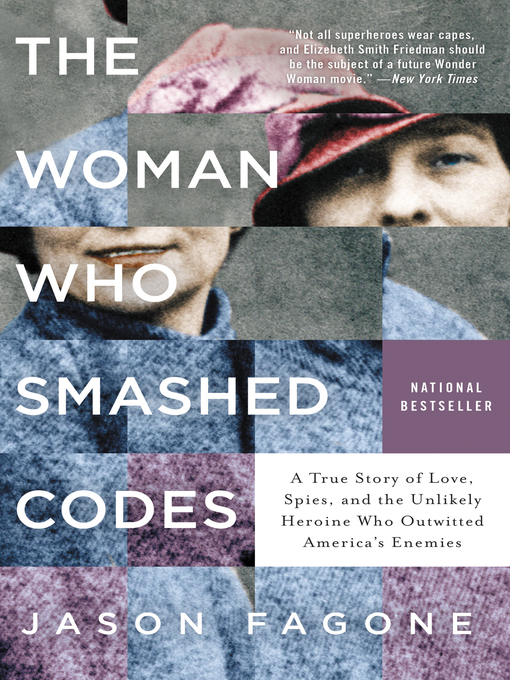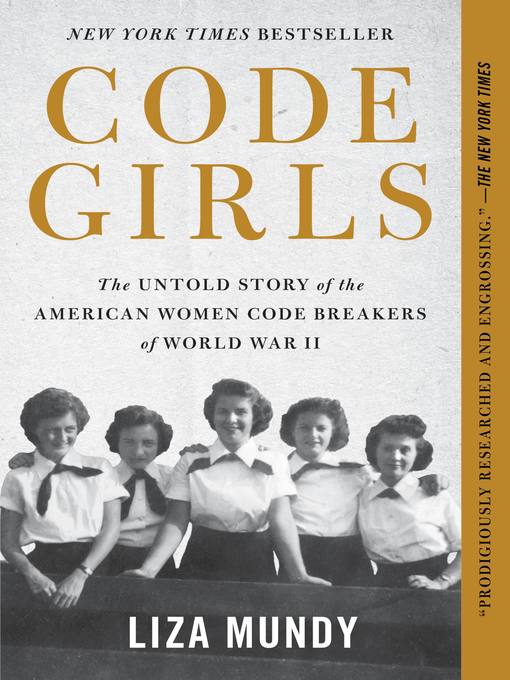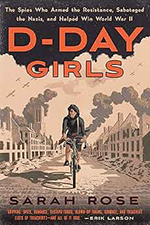 The Woman Who Smashed Codes
The Woman Who Smashed Codes
by Jason Fagone
GENRE: Nonfiction, Biography, History, WWII
An introduction to eccentric businessman George Fabyan changed Elizebeth Smith’s life. She moved to the Fabyan estate, met her future husband, and went on to become the pre-eminent codebreaker during both world wars. This nonfiction book has many ties to Geneva, and illuminates the contributions of this remarkable woman.
 Author Biography
Author Biography
Jason Fagone is a journalist who covers science, technology, and culture. Named one of the “Ten Young Writers on the Rise” by the Columbia Journalism Review, he works at the San Francisco Chronicle and has written for GQ, Esquire, The Atlantic, the New York Times, Mother Jones, and Philadelphia magazine. Fagone is also the author of Ingenious: A True Story of Invention, the X Prize, and the Race to Revive America and Horsemen of the Esophagus: Competitive Eating and the Big Fat American Dream. He lives in San Francisco, California. - HarperCollins
Library Journal
/* Starred Review */ Two forces set Elizebeth Friedman on the path to success: her love of literature and her fear of being ordinary. The first led her to the Newberry Library in Chicago to see a rare copy of William Shakespeare's First Folio. There, a librarian introduced her to a rich, eccentric stranger named George Fabayan. Against her sound judgment, Friedman accepted an unusual assignment at Fabayan's laboratory of decrypting Shakespeare's works. Friedman met her husband, William, at the laboratory and they eventually became two of the world's top cryptologists. William and Elizebeth solved some of the toughest crimes and military intelligence challenges of the 20th century. Fagone, editor for the Huffington Post Highline, records the pair's accomplishments, trials, and love affair, taking care to ensure that Elizebeth finally receives the recognition she deserves. The impressive endnotes will prove useful to researchers who wish to further explore the contributions of female codebreakers. VERDICT Fans of Margot Lee Shetterly's Hidden Figures and Andrew Hodges's Alan Turing: The Enigma will enjoy this carefully researched story of a smart and loyal but overlooked woman. [See Prepub Alert, 1/23/17.]—Beth Dalton, Littleton, CO --Beth Dalton (Reviewed 08/01/2017) (Library Journal, vol 142, issue 13, p103)
Kirkus Reviews
The wife of the groundbreaking cryptanalyst William Friedman finally gets her due as equal partner in their pioneering codebreaking work over 30 years. While her husband was long treated by the National Security Agency as the "founder of the science of modern American cryptology," it was the partnership with his wife, Elizebeth that drove the two to brilliant heights in the field. Journalist Fagone (Ingenious: A True Story of Invention, Automotive Daring, and the Race to Revive America, 2013, etc.) does a bang-up research effort in unearthing the true story of this humble Midwestern codebreaker, who often gave her husband the credit while her own work (and much of his) had to remain in secrecy because of concerns of national security. However, the sexism of the time would also play a role in how her work was undervalued and underreported; as the author notes, "when powerful men started to tell the story [e.g., FBI director J. Edgar Hoover], they left her out of it." A remarkable meeting of the minds occurred when Elizebeth, a recent college graduate, was introduced to William, a mild-mannered geneticist, at the wealthy Chicago businessman George Fabyan's fabulous Riverbank "laboratory" in Geneva, Illinois, in 1916. Elizebeth had been hired to figure out the cipher in Shakespeare's First Folio that was supposed to reveal its author as Francis Bacon, and while she lost faith in the project, she found she had a knack for code-breaking. With the war escalating, she and William led the "Riverbank Department of Ciphers," fed by a stream of encrypted messages from Washington, D.C. Over time, they developed into a fine-tuned team, and Fagone explains without arduous technicality how the process worked—then pen and paper, without machines. Between the wars, the two wrote books, and Elizebeth helped crack messages from rumrunners for the Coast Guard. World War II brought the challenges of breaking Magic and Enigma, among other astounding achievements across the globe. An engaging resurrection of a significant player in the world of cryptology. (Kirkus Reviews, July 15, 2017)
Booklist
*Starred Review* Fans of forgotten history, take note. Fagone (Ingenious: A True Story of Invention, Automotive Daring, and the Race to Revive America, 2013) has found a twentieth-century story that reads more like a thriller than nonfiction. Furthermore, Elizebeth Smith Friedman's life has all the hallmarks of a Hollywood hit, and she is long overdue for the limelight. One of the greatest cryptologists of all time, she started her career in 1917, working for a mercurial millionaire who sought to prove that a hidden code exists in Shakespeare's works that reveals Francis Bacon as their true author. After meeting an equally gifted code-breaking genius on that project, William Friedman, the man who became the father of the National Security Agency, the two broke German codes in WWI. Then, as a married couple working for the government, Elizebeth unraveled cyphers created by rumrunners and gangsters during Prohibition, then moved on to undermine the Nazis. She never sought the spotlight, and as others, notably J. Edgar Hoover, took credit for her achievements, she was forced by national security requirements to remain silent. Riveting, inspiring, and rich in colorful characters, Fagone's extensively researched and utterly dazzling title is popular history at its very best and a book club natural.--Mondor, Colleen Copyright 2017 Booklist.
 Code Girls
Code Girls
by Liza Mundy
Recruited by the U.S. Army and Navy from small towns and elite colleges, more than ten thousand women served as codebreakers during World War II. While their brothers and boyfriends took up arms, these women moved to Washington and learned the meticulous work of code-breaking. Their efforts shortened the war, saved countless lives, and gave them access to careers previously denied to them. A strict vow of secrecy nearly erased their efforts from history; now, through dazzling research and interviews with surviving code girls, bestselling author Liza Mundy brings to life this riveting and vital story of American courage, service, and scientific accomplishment.
 D-Day Girls: The Spies Who Armed the Resistance, Sabotaged the Nazis, and Helped Win World War II
D-Day Girls: The Spies Who Armed the Resistance, Sabotaged the Nazis, and Helped Win World War II
by Sarah Rose
In 1942, the Allies were losing, Germany seemed unstoppable, and every able man in England was on the front lines. To “set Europe ablaze,” in the words of Winston Churchill, the Special Operations Executive (SOE), whose spies were trained in everything from demolition to sharpshooting, was forced to do something unprecedented: recruit women. Thirty-nine answered the call, leaving their lives and families to become saboteurs in France.
In D-Day Girls, Sarah Rose draws on recently declassified files, diaries, and oral histories to tell the thrilling story of three of these remarkable women. There’s Andrée Borrel, a scrappy and streetwise Parisian who blew up power lines with the Gestapo hot on her heels; Odette Sansom, an unhappily married suburban mother who saw the SOE as her ticket out of domestic life and into a meaningful adventure; and Lise de Baissac, a fiercely independent member of French colonial high society and the SOE’s unflappable “queen.” Together, they destroyed train lines, ambushed Nazis, plotted prison breaks, and gathered crucial intelligence—laying the groundwork for the D-Day invasion that proved to be the turning point in the war.
Rigorously researched and written with razor-sharp wit, D-Day Girls is an inspiring story for our own moment of resistance: a reminder of what courage—and the energy of politically animated women—can accomplish when the stakes seem incalculably high.
 Agent Sonya: Moscow’s Most Daring Wartime Spy
Agent Sonya: Moscow’s Most Daring Wartime Spy
by Ben Macintyre
This true-life spy story is a masterpiece about the woman code-named "Sonya." Over the course of her career, she was hunted by the Chinese, the Japanese, the Nazis, MI5, MI6, and the FBI--and she evaded them all. Her story reflects the great ideological clash of the twentieth century--between Communism, Fascism, and Western democracy--and casts new light on the spy battles and shifting allegiances of our own times.